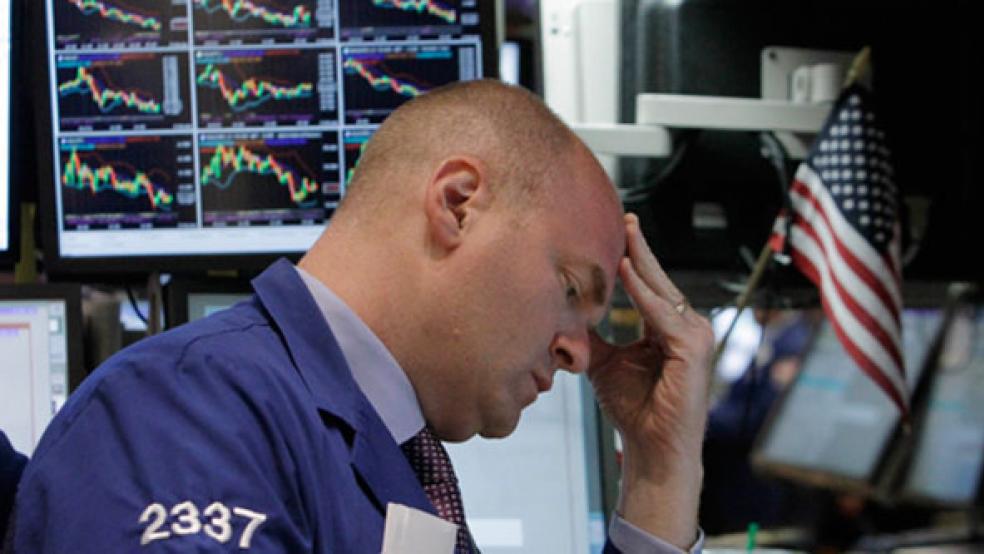While all the attention has been on market volatility in China and the machinations of bailout negotiations in Greece, we've quietly crept up on the start of the 2Q15 earnings season.
Alcoa (AA) kicked things off last week; but we're headed into the meat of the reporting season this week with JPMorgan (JPM), Wells Fargo (WFC), and Johnson & Johnson (JNJ) reporting Tuesday morning. Other big reporters later in the week include Netflix (NFLX), Intel (INTC), Bank of America (BAC), Google (GOOGL), General Electric (GE) and Goldman Sachs (GS). Clearly, the calendar is jam packed.
Related: Say Goodbye to Dow 18,000…for a While
The two big dynamics that corporate managers blamed for ho-hum results in the first quarter — the strong dollar (weighing on foreign profits) and weak crude oil prices (hitting energy revenues) — are set to continue. In fact, according to FactSet data, we're on track for the first drop for S&P 500 earnings on a year-over-year basis since the middle of 2012, with a 4.4 percent decline expected. It would also represent the largest year-over-year earnings decline, on an absolute basis, since the third quarter of 2009.
This estimate has wilted in recent months, deteriorating from original estimate for Q2 earnings per share growth of -2.2 percent as of the end of March. Since then, seven sectors led by industrials have suffered downward revisions. Already, 80 companies in the S&P 500 have issues negative EPS guidance vs. the 27 that have issued positive guidance.
Traditionally, corporate executives look to manage down expectations so that they can report upside surprises and juice their stock price (and thus, the value of their stock options) when the actual numbers are released. Over the last four years, on average 72 percent of S&P 500 companies have reported earnings per share numbers above analysts’ mean estimate. As a result, the overall earnings growth rate over that time has increased 2.9 percent on average from the end of the quarter to the end of the resulting earnings reporting season. If this average were applied to the estimated earnings growth rate for Q2, we should expect the decline to moderate to -1.6 percent over last year.
If so, that would be the first outright decline in earnings per share since the third quarter of 2012.
Related: What the U.S. Must Do to Avoid Another Financial Crisis
Something similar was expected to happen heading into the 1Q15 reporting season, with estimates braced for a 4.6 percent decline in earnings per share. The actual result was 0.8 percent growth thanks to shrewd earnings management and accounting trickery.
Can it happen again? Much depends on how well corporate treasurers have managed the strong U.S. dollar. An analysis of the 24 S&P 500 companies that have already reported results reveals that 17 have cited the strong dollar or currency movements as having a negative impact on results vs. just one, Walgreens Boots Alliance (WBA), mentioning the situation in Greece, but in the context of its impact on the overall currency market.
At the sector level, the focus will be on energy. It's been hit the hardest (earnings expected to fall 57.4 percent), especially the shale players in the gas exploration and production space (earnings expected to fall 108 percent). Without the drag from energy, overall S&P 500 earnings growth would be expected to total 2.0 percent over last year.
Related: What's Next for Oil Prices? Look Out Below!
Yet it's also an area where prices and valuations are elevated on the implicit assumption energy prices will soon rise again: The price-to-earnings multiple for the energy sector stands at 23.8 vs. a 10-year average of 12.6.
Overall, analysts don't currently expect earnings growth to return until the fourth quarter while revenue growth isn't expected to return until the first quarter of 2016. Given this, prices look fully valued with the S&P 500's forward price-to-earnings multiple at 16.2 — above its five-year average of 13.9 and above the 10-year average of 14.1.
Top Reads from The Fiscal Times:






